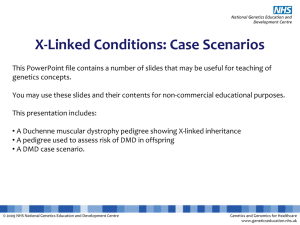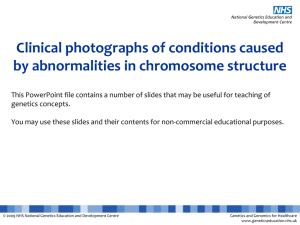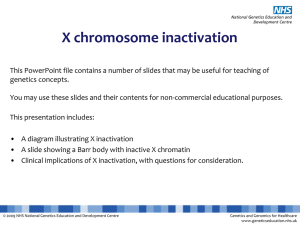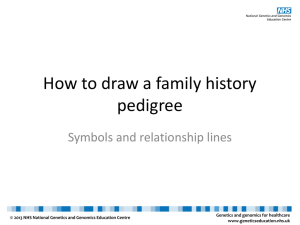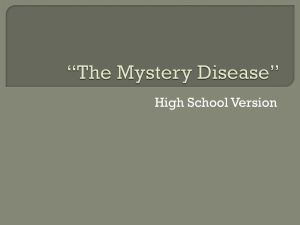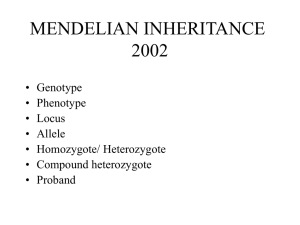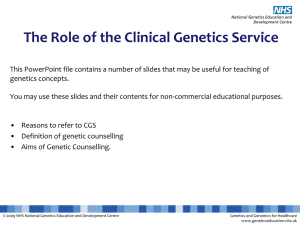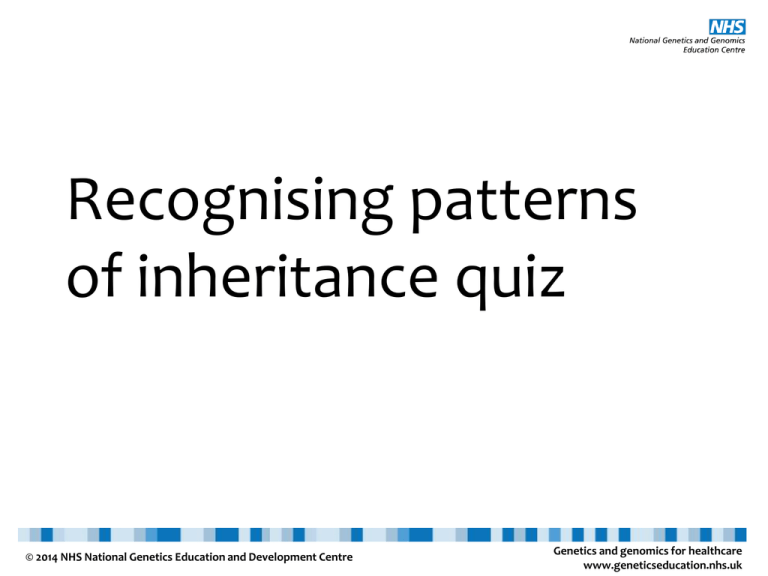
Recognising patterns
of inheritance quiz
© 2014 NHS National Genetics Education and Development Centre
Genetics and genomics for healthcare
www.geneticseducation.nhs.uk
• This quiz was designed to help in identifying the
different patterns of inheritance by analysing how
people with a condition are related to each other.
• In practice, additional information may be
available:
– For instance, the diagnosis itself may confirm a mode of
inheritance. Then, the pedigree can be inspected to see
if the pattern fits with that expected.
– Some combinations of clinical features may suggest that
the condition is due to an anomaly of chromosomes.
© 2014 NHS National Genetics Education and Development Centre
Genetics and genomics for healthcare
www.geneticseducation.nhs.uk
Introduction
• There are 10 genetic family histories (illustrated as pedigrees) in this
quiz.
• The first slide for each family gives the pedigree and invites you to
choose the most likely mode of inheritance from a list of 4 or 5
alternatives.
• The second slide for each family gives the answer we think most likely
and gives explanations in the notes pane as to why some of the other
alternatives are not appropriate.
• In the explanations, we often use the term “affected people”. Patients
much prefer the term “people with the condition” but we use the term
“affected” here as a shorthand form to save space.
© 2014 NHS National Genetics Education and Development Centre
Genetics and genomics for healthcare
www.geneticseducation.nhs.uk
Additional resources
• Animated presentations explaining the single gene
modes of inheritance can be found here:
http://www.geneticseducation.nhs.uk/forhealthcare-educators/presentations
• Video animations explaining single gene modes of
inheritance can be found via the following page:
http://www.geneticseducation.nhs.uk/mededu/mo
des-of-inheritance/single-gene-conditions
© 2014 NHS National Genetics Education and Development Centre
Genetics and genomics for healthcare
www.geneticseducation.nhs.uk
Some reminders before you begin
• The internationally agreed symbols for males
and females are squares and circles
respectively.
• A symbol is coloured in if the person has a
condition.
• Small triangles are miscarriages or
spontaneous abortions.
• The sex chromosomes of males are XY;
females have XX sex chromosomes.
• Mitochondria come from the egg and not
the sperm.
© 2014 NHS National Genetics Education and Development Centre
Genetics and genomics for healthcare
www.geneticseducation.nhs.uk
Questions to consider when
looking at a pedigree
• Do males and females have the condition?
• Are there roughly equal numbers of males and females with
the condition?
• Are there people in each generation with the condition?
• Do people with the condition have children with the
condition?
• Do people without the condition have children with the
condition?
© 2014 NHS National Genetics Education and Development Centre
Genetics and genomics for healthcare
www.geneticseducation.nhs.uk
Family 1
Which of the modes of inheritance is the most likely based on the pattern
of people with the condition in this family?
a. Chromosomal translocation
b. Autosomal dominant
c. X-linked dominant
d. Mitochondrial
e. Autosomal recessive
© 2014 NHS National Genetics Education and Development Centre
Genetics and genomics for healthcare
www.geneticseducation.nhs.uk
Family 1
Which of the modes of inheritance is the most likely based on the pattern
of people with the condition in this family?
a. Chromosomal translocation
b. Autosomal dominant
c. X-linked dominant
d. Mitochondrial
e. Autosomal recessive
© 2014 NHS National Genetics Education and Development Centre
Genetics and genomics for healthcare
www.geneticseducation.nhs.uk
Family 2
Which of the modes of inheritance is the most likely based on the pattern
of people with the condition in this family?
a. Y linked
b. Autosomal recessive
c. Autosomal dominant
d. X-linked recessive
e. X-linked dominant
© 2014 NHS National Genetics Education and Development Centre
Genetics and genomics for healthcare
www.geneticseducation.nhs.uk
Family 2
Which of the modes of inheritance is the most likely based on the pattern
of people with the condition in this family?
a. Y linked
b. Autosomal recessive
c. Autosomal dominant
d. X-linked recessive
e. X-linked dominant
© 2014 NHS National Genetics Education and Development Centre
Genetics and genomics for healthcare
www.geneticseducation.nhs.uk
Family 3
Which of the modes of inheritance is the most likely based on the pattern of people with the
condition in this family?
The affected person has a metabolic disorder caused by an enzyme deficiency. The disorder
causes learning disabilities, coarsening of the facial features and skeletal anomalies.
a. Autosomal dominant
b. Autosomal recessive
c. X-linked recessive
d. Multifactorial
© 2014 NHS National Genetics Education and Development Centre
Genetics and genomics for healthcare
www.geneticseducation.nhs.uk
Family 3
Which of the modes of inheritance is the most likely based on the pattern of people with the
condition in this family?
The affected person has a metabolic disorder caused by an enzyme deficiency. The disorder
causes learning disabilities, coarsening of the facial features and skeletal anomalies.
a. Autosomal dominant
b. Autosomal recessive
c. X-linked recessive
d. Multifactorial
© 2014 NHS National Genetics Education and Development Centre
Genetics and genomics for healthcare
www.geneticseducation.nhs.uk
Family 4
Which of the modes of inheritance is the most likely based on the pattern of people with the
condition in this family?
a. Reciprocal chromosomal translocation
b. Autosomal dominant
c. X-linked dominant
d. Mitochondrial
e. Autosomal recessive
© 2014 NHS National Genetics Education and Development Centre
Genetics and genomics for healthcare
www.geneticseducation.nhs.uk
Family 4
Which of the modes of inheritance is the most likely based on the pattern of people with the
condition in this family?
a. Reciprocal chromosomal translocation
b. Autosomal dominant
c. X-linked dominant
d. Mitochondrial
e. Autosomal recessive
© 2014 NHS National Genetics Education and Development Centre
Genetics and genomics for healthcare
www.geneticseducation.nhs.uk
Family 5
Which of the modes of inheritance is the most likely based on the pattern of people with the
condition in this family?
Two people were born with spina bifida but are otherwise healthy.
a. X-linked recessive
b. Mitochondrial
c. Autosomal dominant
d. Multifactorial
© 2014 NHS National Genetics Education and Development Centre
Genetics and genomics for healthcare
www.geneticseducation.nhs.uk
Family 5
Which of the modes of inheritance is the most likely based on the pattern of people with the
condition in this family?
Two people were born with spina bifida but are otherwise healthy.
a. X-linked recessive
b. Mitochondrial
c. Autosomal dominant
d. Multifactorial
© 2014 NHS National Genetics Education and Development Centre
Genetics and genomics for healthcare
www.geneticseducation.nhs.uk
Family 6
The children with the condition in this family have multiple congenital anomalies and
developmental delay. Which of the modes of inheritance is the most likely based on the
pattern of people with the condition in this family?
a. Reciprocal chromosomal translocation
b. Autosomal dominant
c. X-Linked recessive
d. Mitochondrial
e. Autosomal recessive
© 2014 NHS National Genetics Education and Development Centre
Genetics and genomics for healthcare
www.geneticseducation.nhs.uk
Family 6
The children with the condition in this family have multiple congenital anomalies and
developmental delay. Which of the modes of inheritance is the most likely based on the
pattern of people with the condition in this family?
a. Reciprocal chromosomal translocation
b. Autosomal dominant
c. X-Linked recessive
d. Mitochondrial
e. Autosomal recessive
© 2014 NHS National Genetics Education and Development Centre
Genetics and genomics for healthcare
www.geneticseducation.nhs.uk
Family 7
Which of the modes of inheritance is the most likely based on the pattern of people with the
condition in this family?
a. X-linked dominant
b. Autosomal dominant
c. Multifactorial
d. X-Linked recessive
e. Reciprocal chromosomal translocation
© 2014 NHS National Genetics Education and Development Centre
Genetics and genomics for healthcare
www.geneticseducation.nhs.uk
Family 7
Which of the modes of inheritance is the most likely based on the pattern of people with the
condition in this family?
a. X-linked dominant
b. Autosomal dominant
c. Multifactorial
d. X-Linked recessive
e. Reciprocal chromosomal translocation
© 2014 NHS National Genetics Education and Development Centre
Genetics and genomics for healthcare
www.geneticseducation.nhs.uk
Family 8
Which of the modes of inheritance is the most likely based on the pattern of people with the
condition in this family?
a. Autosomal dominant
b. Autosomal recessive
c. X-Linked recessive
d. Y-Linked
e. X-Linked dominant
© 2014 NHS National Genetics Education and Development Centre
Genetics and genomics for healthcare
www.geneticseducation.nhs.uk
Family 8
Which of the modes of inheritance is the most likely based on the pattern of people with the
condition in this family?
a. Autosomal dominant
b. Autosomal recessive
c. X-Linked recessive
d. Y-Linked
e. X-Linked dominant
© 2014 NHS National Genetics Education and Development Centre
Genetics and genomics for healthcare
www.geneticseducation.nhs.uk
Family 9
Which of the modes of inheritance is the most likely based on the pattern of people with the
medical condition in this family?
a. X-linked recessive
b. Reciprocal chromosomal translocation
c. Mitochondrial
d. New mutation causing a dominant condition
e. Autosomal recessive
© 2014 NHS National Genetics Education and Development Centre
Genetics and genomics for healthcare
www.geneticseducation.nhs.uk
Family 9
Which of the modes of inheritance is the most likely based on the pattern of people with the
medical condition in this family?
a. X-linked recessive
b. Reciprocal chromosomal translocation
c. Mitochondrial
d. New mutation causing a dominant condition
e. Autosomal recessive
© 2014 NHS National Genetics Education and Development Centre
Genetics and genomics for healthcare
www.geneticseducation.nhs.uk
Family 10
Which of the modes of inheritance is the most likely based on the pattern of people with the
condition in this family?
a. X-linked dominant
b. Autosomal dominant
c. X-linked recessive
d. Mitochondrial
e. Y-linked
© 2014 NHS National Genetics Education and Development Centre
Genetics and genomics for healthcare
www.geneticseducation.nhs.uk
Family 10
Which of the modes of inheritance is the most likely based on the pattern of people with the
condition in this family?
a. X-linked dominant
b. Autosomal dominant
c. X-linked recessive
d. Mitochondrial
e. Y-linked
© 2014 NHS National Genetics Education and Development Centre
Genetics and genomics for healthcare
www.geneticseducation.nhs.uk

